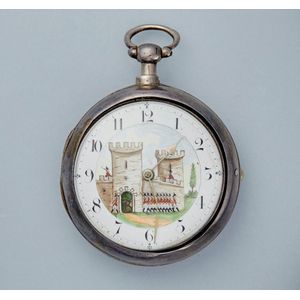William Mann Silver Verge Escapement Automaton Watch
You must be a subscriber, and be logged in to view price and dealer details.
Subscribe Now to view actual auction price for this item
When you subscribe, you have the option of setting the currency in which to display prices to $Au, $US, $NZ or Stg.
- Verge Escapement - A verge escapement is an early mechanical escapement used in clocks and other timekeeping devices. It is an early form of the escapement mechanism, which is used to regulate the movement of the hands of a clock or watch. The verge escapement consists of a vertical shaft called the verge, which is mounted on the clock's main plate. Attached to the verge are two pallets, which engage with the teeth of the escape wheel. As the escape wheel turns, the pallets alternately lock and release it, allowing the movement of the clock to be regulated. The verge escapement was widely used in early mechanical clocks, but it was eventually replaced by the more accurate and reliable anchor escapement.
- Fusee - The fusee movement was used in clocks and pocket watches from the mid 17th century. The fusee is a cone shaped drum within the works that is linked to the barrel of the spring, usually by a length of chain.
As the mainspring loses its tension over time, the cone shaped barrel compensates for this by increasing the tension, by pulling the mainspring tighter, thus ensuring the time remains constant.
Use of the fusee in clocks was superseded by the "going barrel" in the mid 19th century and for pocket watches at the beginning of the 19th century.
The fusee continued to be used in marine chronometers until the 1970s. - Movement - The technical name for the workings of a clock or watch, and does not include the dial or case.
- Date Aperture - A date aperture is a cut out section in the face of a watch or clock, displaying the day of the month.
This item has been included into following indexes:
- clocks, type - automata / automaton 42
- militaria - military clocks, watches and chronometers 102
-
pocket watches, case type
- open face, silver case 514
- pair cased 143
- silver case 816
- pocket watches, period - Georgian 240
Visually similar items

A c.1910 European Hebdomas gent's pocket watch, the open face with Ð pale pink and white enamel dial, decorated with applied gold and silver florals, Roman numerals, the exposed escapement with scroll engraved plates, nickel plated case, the back plate wit

A gilt metal and polychrome enamel open-faced verge watch Continental circa 1810, gilt full-plate movement, verge fusee escapement, concealed beneath a decoratively pierced backplate, pierced balance cock engraved with floral scrolls, cylindrical pillars,

A silver pair cased open faced pocket by James wood Brighton, sterling silver, presented with polished outer case, white enamel dial, Arabic numerals, gold hands, elongated pendant, key wind, case hallmarked London 1800, John Bestall. Movement engraved Jam

Ladies 9ct gold body&silver enamelled pocket watch, enamelled in a red and black leaf pattern, open face, with white enamel face and second hand movement, marked 0,935, size: 3.5 cm high including winder
